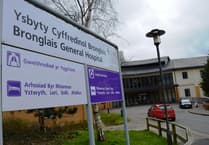Wales’s junior doctors are underpaid, overworked and worn out. They may also be victims of a Welsh government con.
Increasingly, it looks as if these imposed-upon hospital frontliners are being taken for a ride by an administration set on blocking a steady advance towards strike action.
Junior doctors of the Wales BMA – the doctors’ trade union – last month voted to reject a decidedly derisory three per cent pay offer, but which included a “commitment” by Health Minister Eluned Morgan to the principle of restoring junior doctor pay to 2008 levels.
Oh, wonderful! A commitment! And when will that principle translate to money in the bank? Er, well, there’s actually no word on that, because the minister is asking for more “meaningful conversations” on the subject. Translated, she’s playing for time.
But can we take it that, given a few more positive chats with Eluned, she will come up with a commitment with a clear timeframe, one which deals fully and fairly with the doctors’ grievances?
Well, perhaps not. In fact, in all likelihood such a conclusion would involve a wildly optimistic leap of faith, an unevidenced confidence that Welsh governments which have consistently looked the other way on this very important issue will suddenly start acting diligently.
The struggle of junior doctors - that is, all those below consultant level - for pay justice is beyond reproach. They are trying to claw back losses from a staggering 26 per cent real-terms cut in pay tolerated by neglectful Cardiff and Westminster administrations over the last 15 years or, if you prefer, since 2008’s deregulation-generated financial crisis.
That nugget of gross UK Government mismanagement is now being succeeded by what looks very much like a grimy dose of cynicism. Desperate to keep the lid on the medics’ simmering anger, Eluned Morgan offers them something meant to look like a demonstration of solidarity. In fact, it is no more than a delaying tactic.
She is stringing along the BMA with a totally unsubstantiated ‘commitment’ to pay restoration, while fully aware that a commitment without a timeline is meaningless.
Meanwhile, events march on. In Scotland, junior doctors ballot this week on whether to take industrial action. In England, they have decided on a four-day strike between 11 and 15 April in their fight to catch up on 15 years of pay freezes and one per cent salary increases.
And in Wales? The BMA’s Welsh junior doctors committee, showing the patience of a saint, calls the health minister’s “commitment” to pay restoration a “positive step”, but one which “does not go far enough”, adding: “We have now written to the minister…to request a clear timeframe for them to make good on their commitment”.
“In a nutshell,” the BMA tells me, “we are not currently in dispute with the Welsh government. We are actively involved in discussions on pay.”
The generosity and forbearance of these vastly put-upon doctors in their engagement with the government is almost certainly unwise. Their English and Scottish colleagues meanwhile have decided enough is enough, that they are no longer prepared to go on being exploited.
The facts in favour of a tougher approach speak for themselves. The £26,714 minimum pay of junior doctors in Wales is up to £2,671 less than received by fellow BMA members in England and Scotland, and dramatically less than elsewhere in Europe. (A snapshot comparison: Ireland pays its junior doctors a minimum of £54,547; Greece, £58,788; Italy, £78,710; Spain, £65,315; Switzerland, £85,169.)
This struggle is not only about pay. It’s also about human wear and tear. If you happen to be admitted to Bronglais Hospital, or any number of other hospitals up and down Wales, there is a fair chance you will be under the care of a junior doctor who is knackered, who is working an additional shift outside contracted hours for derisory extra pay.
The General Medical Council knows this. The body overseeing protection of patient safety is warning that burnout, and increased levels of exhaustion, among such medics are at the highest ever levels recorded. Yet the dangerous injustice of low and disgracefully eroded pay grinds on.
Ultimately, it’s as well to remember that the last thing these dedicated life-saving professionals want is the strife and stress of going on strike. They want a quiet life. To be able to get on with the job they’ve spent ages training to do without constant nagging worries about money and debt. Militancy has been forced on them by governments which for years have acted as little more than bystanders while salaries have fallen through the floor.
Feebly, the Welsh Government will claim it can do no more, that it has had no choice but to hope the UK Government ups its offer to NHS staff in England, whereupon extra money would come its way under the Barnett formula, the Treasury mechanism which regulates cash allocations to the devolved governments.
This to miss the point. Cardiff’s culpability is that it has allowed pay injustice for junior doctors to gather pace and to fester for 15 years. It should not expect anyone to believe that, for so long, it has been powerless to stop the rot.
Filling the blank walls at the National Library...
To the National Library, and an exhibition of prints of rare magnificence, including dozens of exquisite engravings and etchings by Rembrandt, Dürer, Augustus John and Whistler.
These are from bequests to the library by the sisters Gwendoline and Margaret Davies, rich and avid art collectors who died respectively in 1951 and 1963. Enabled by the inherited wealth of their grandfather, David Davies, a mining, railways and docks magnate from Llandinam, they amassed one of the 20th century’s great British art collections and donated substantially to the library and to the National Museum of Wales. They also helped to pay for the library’s elegant Gregynog Gallery, where these riveting prints are displayed.
These are triumphant days for the national library, which has just launched its fascinating and wide-ranging Wales Broadcast Archives, a gargantuan undertaking of huge importance nationally.
A single positive suggestion: the library could make itself an even more interesting place to make for if it filled its acres of blank wall-space - notably leading from the main entrance - with some of its many thousands of publicly-owned paintings and other fine art works stored in the building and rarely, if ever, seen. Hundreds, I calculate, could be hung in the entrance hall alone.





Comments
This article has no comments yet. Be the first to leave a comment.